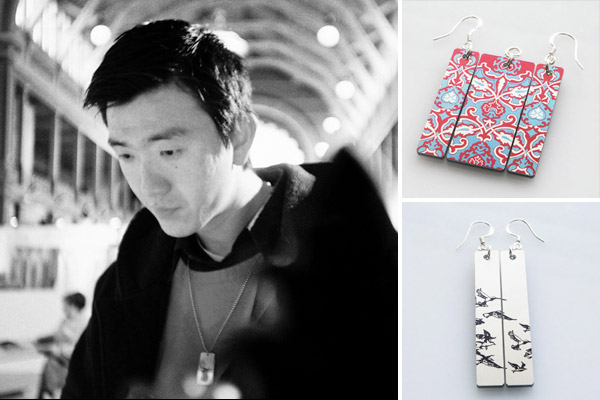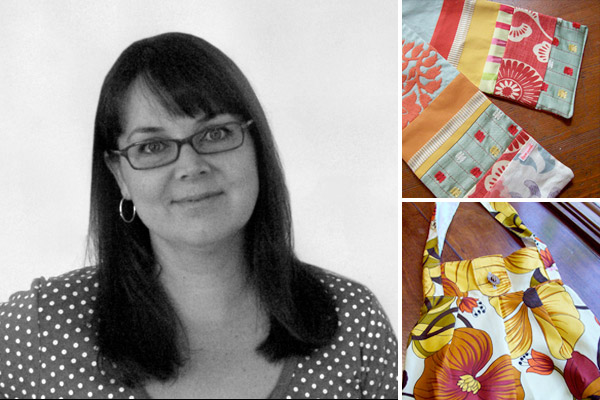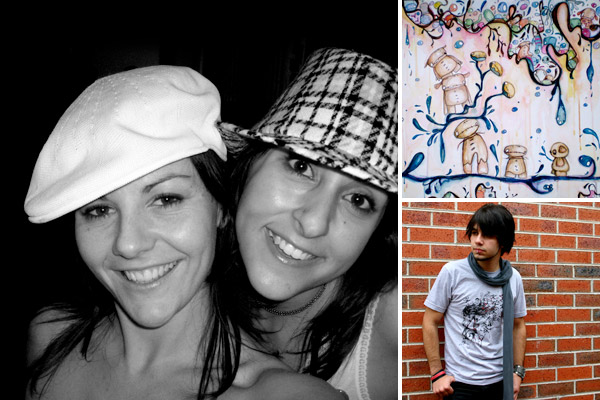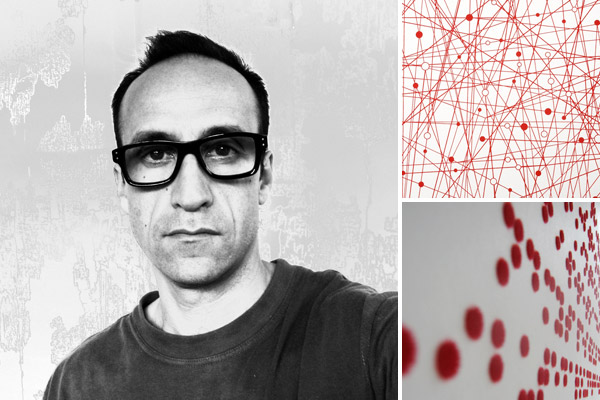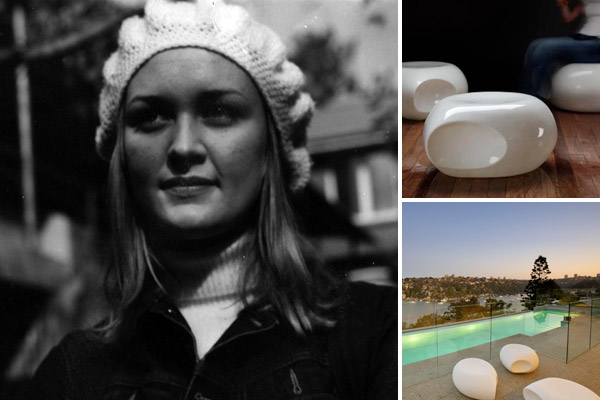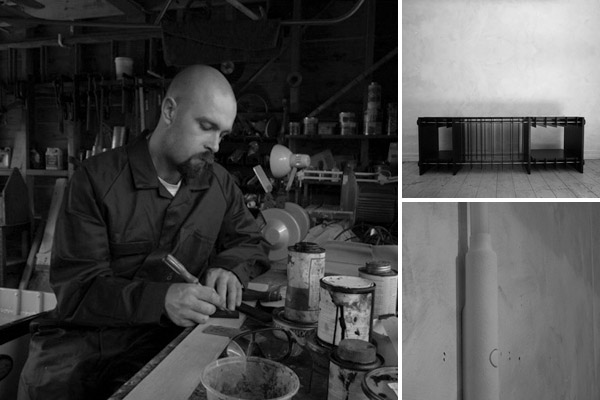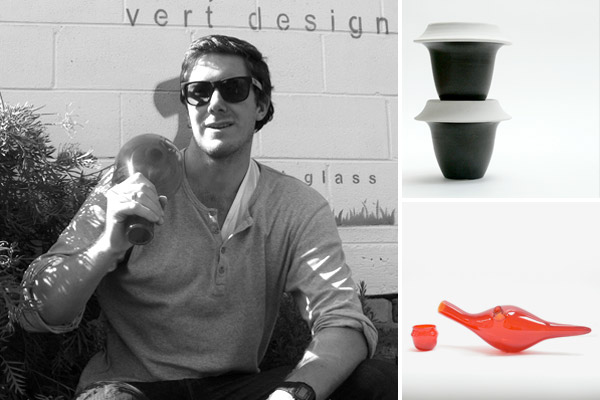July 2008
Bridget Bodenham
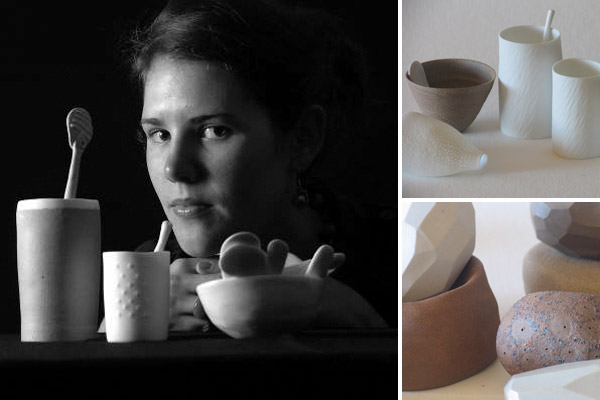
Bridget Bodenham | Email
Where and what did you study and what year did you graduate?
Diploma of Arts (Ceramics), 2006, University of Ballarat.
Where did you head after graduating?
After graduating I took part in the New Enterprise Incentive Scheme (NEIS) and have spend the last year setting up a studio with studio equipment
When did you launch your own business?
End of 2007.
What motivated you to start your own business?
I am motivated by the enjoyment of making objects, cooking and sharing.
How would you describe your business to someone who didn’t know you?
My business is designing and making objects from clay that have functional possibilities. I make tableware, utensils and jewellery.
How would you describe the products you design to someone who hadn’t seen them?
My work explores weight, texture and form. As a group of objects they invite touch. They are handmoulded, pierced and faceted forms that fit as well into the hand as they sit on the shelf.
What are the most challenging parts of being a designer running a small business?
I think the most challenging part is finding time to do everything and to still develop creatively.
What inspires your design projects?
I am inspired by people, nature and culture.
What are the next steps for you?
I hope to continue making and developing a range of ceramics that is widely used, to collaborate with other makers and materials and to be recognised as an artist and designer.
Comments Off on Bridget Bodenham
Brad Nicholls
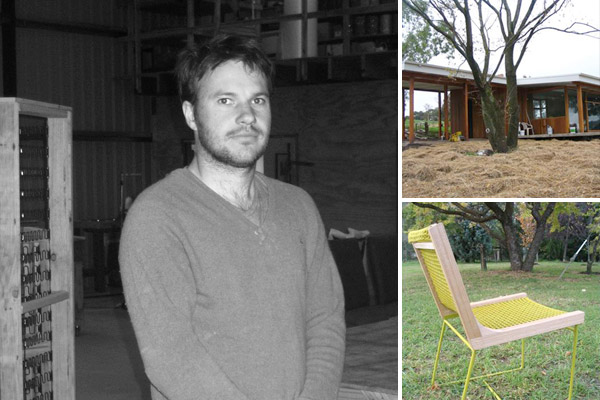
Nicholls Design | Email
Where did you head after graduating?
I worked in the family retail business and spent a number of years travelling the coastal regions of Australia. During this time, I was inspired by natural elements and drawn to earth tones and textures which are featured in my designs.
When did you launch your own business?
In 2004.
What motivated you to start your own business?
Artistic creativity runs in the family. My older brothers are both artists and they inspired me to get involved in a creative field. I always enjoyed making furniture and dreamt of having my own business.
How would you describe your business to someone who didn’t know you?
Nicholls Design is involved in design, design collaboration and customised manufacture. I enjoy the challenge of manufacturing different ideas.
How would you describe the products you design to someone who hadn’t seen them?
Clean lines, earth colours and organic mediums.
What are the most challenging parts of being a designer running a small business?
I find administration and time management challenging. I take an intuitive approach to design and find this organic, hands on approach works well for my creative process but this can be to my disadvantage when commonly design requests are based on computer illustrated design methods.
What inspires your design projects?
I am inspired by mid-century modernism. In particular the Scandanavian design simplicity as design from that era is timeless and still looks good in a contempory setting. I aspire to replicate timeless design in my own furniture. I find materials and design ideas from my life experiences.
What are the next steps for you?
I hope to be well established and recognised not only for my distinctive design but also for my manufacturing attention to detail and my low environmental footprint. I am currently building a house that I designed. This has been a big project which has absorbed most of my time and energy and I will hopefully have completed in the next couple of months. Although enjoyable and challenging I look forward to focusing my full attention back on my business.
Comments Off on Brad Nicholls
Alister Yiap
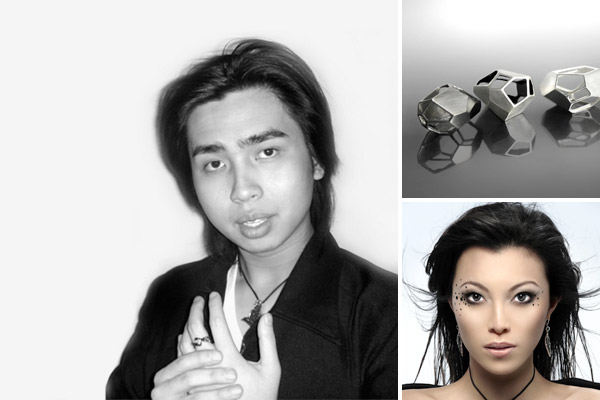
Malachi Alister Yiap | Email | Website
Where and what did you study and what year did you graduate?
Bachelor of Arts (Jewellery Design), 2007, Curtin University of Technology.
When did you launch your own business?
In mid-2006.
What motivated you to start your own business?
I was motivated to start my own business by wanting to establish myself as a designer.
How would you describe your business to someone who didn’t know you?
I am a jewellery designer who deals with a wide range of jewellery practices including commercial, contemporary and couture.
How would you describe the products you design to someone who hadn’t seen them?
I design unique pieces of jewellery, some more practical then others. I would describe them as innovative, inspiring and captivating.
What are the most challenging parts of being a designer running a small business?
Managing time and having to do it all yourself.
What inspires your design projects?
I am always thinking about quality of work and doing things to the best of my ability.
What are the next steps for you?
I’d like to see my business trade on an small scale international level with some important clients.
Alister Yiap received a scholarship from the State Government of Western Australia through the Department of Culture and the Arts to participate in Springboard Stage One.
Comments Off on Alister Yiap
Alexi Freeman
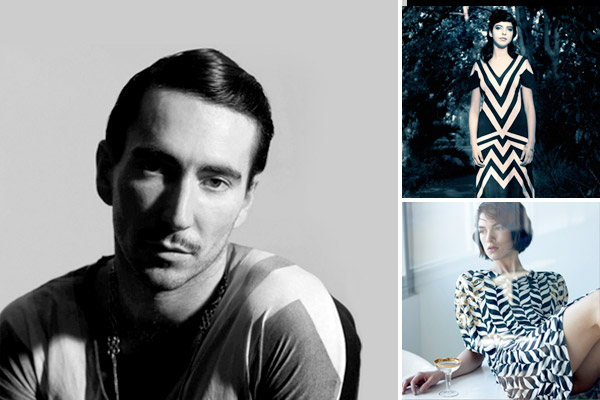
Alexi Freeman | Email | Website
Where and what did you study and what year did you graduate?
Bachelor of Fine Arts (Printmaking and Sculpture), 2004, University of Tasmania.
Where did you head after graduating?
I immediately started showing and selling my works on paper through commercial galleries in Hobart and Melbourne and also limited edition garments through boutiques in Australia and New York .
When did you launch your own business?
I officially launched my women’s label at Milly Sleeping in Carlton in 2006. But I have been working professionally as an artist and bespoke fashion designer since about 1998.
How would you describe your business to someone who didn’t know you?
Alexi Freeman is an independent fashion label that produces seasonal collections of prêet-a-porter women’’s wear and the occasional object d’’art.
How would you describe the products you design to someone who hadn’t seen them?
Casual, sexy and alluring, an Alexi Freeman product is a beautiful, luxurious and wearable celebration of the graphic beauty of life. They are directional in design while highly relevant to the modern woman. It’’s high fashion that you can wear to the supermarket!
What are the most challenging parts of being a designer running a small business?
I think the most challenging thing is having to wear so many different hats. On any given day I am designer, accountant, secretary, production coordinator…
What inspires your design projects?
My collections are inspired by the infinite possibilities of form, colour and texture. I am excited by the opportunity to present something unique yet simultaneously wearable to the market, that is manufactured ethically with considerations to the longevity of design and materials.
What are the next steps for you?
My plan is to continue to produce seasonal women’s wear collections. I also plan to broaden my distribution within the domestic and international market and to open a Melbourne based flagship store by the end of 2009.
Alexi Freeman received a scholarship from Design Victoria to participate in Springboard Stage One.
Comments Off on Alexi Freeman
Trent Barrett
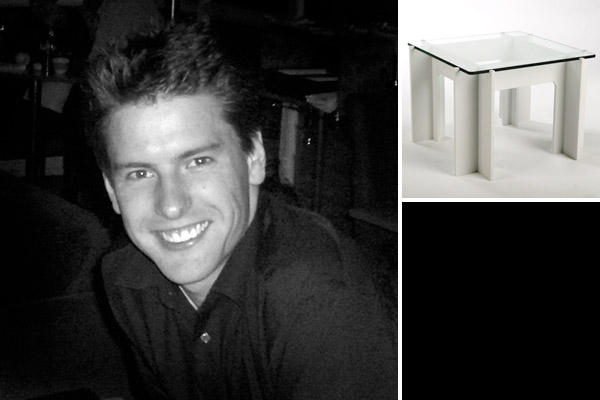
Trent Furniture | Email | Website
Where and what did you study and what year did you graduate?
Bachelor of Industrial Design, 2000, University of New South Wales.
Where did you head after graduating?
I had industrial design experience with Pongrass Furniture and Johnson & Johnson.
When did you launch your own business?
I launched the business in 2003 while I was still working in other jobs.
What motivated you to start your own business?
I had a desire to create both from a design perspective and entrepreneurially.
How would you describe your business to someone who didn’t know you?
We are custom furniture design and fitout solution providers.
How would you describe the products you design to someone who hadn’t seen them?
We have two key areas of work. Our Signature Series is an ongoing experiment and exploration in furniture aesthetics. Each piece in this range is an expression of our creative approach with a story behind the way each piece comes together to look the way that it does. We also work in custom commercial and residential design. This work is about designing furniture and interior elements to specific client needs either for their home or for commercial spaces such as office and hotel interiors.
What are the most challenging parts of being a designer running a small business?
I think the most difficult part is keeping a commercial head whilst remaining creative. Also sourcing of new clients.
What inspires your design projects?
Lots of things but probably our most significant influences are architecture, nature and exploring new uses for materials.
Comments Off on Trent Barrett
Simone Madigan
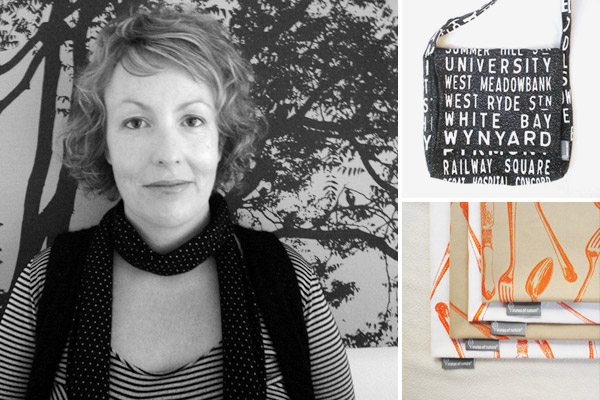
States of Nature | Website | Blog
Where and what did you study and what year did you graduate?
Currently completing Master of Fine Arts (Printmaking), University of Newcastle.
Bachelor of Arts (Graphic Design), 1993, Ballarat University.
Where did you head after graduating?
I worked as an illustrator and graphic designer for fashion and interiors and also taught design in the tertiary sector.
When did you launch your own business?
In 2007.
What motivated you to start your own business?
I designed my own prints for clothing and homewares and friends and family encouraged me to make products for them also.
How would you describe your business to someone who didn’t know you?
States of Nature manufactures specialist handcrafted fabric using water-based inks and sustainable practices. Designs are printed onto linen, cotton and canvas blends to create clothing, accessories and homeware ranges.
How would you describe the products you design to someone who hadn’t seen them?
Many of my designs are based on nature. Some forms are quite obvious but others are more abstract. The way that colours interact and the tactile nature of my products are a focus. I like to mix different prints together and create new pieces that way.
What are the most challenging parts of being a designer running a small business?
There are always competing demands on my time.
What inspires your design projects?
The hands on experience of printmaking and the way I can use digital technology as a tool in my work.
What are the next steps for you?
I hope to develop my use of organic cotton and bamboo fabrics and maintain production in Australia.
Comments Off on Simone Madigan
Rohan Nichol
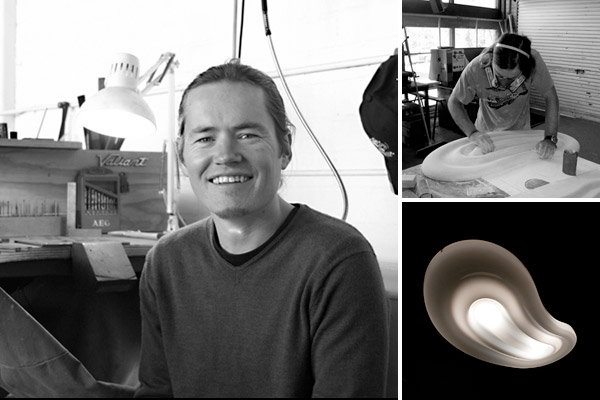
Rohan Nichol | Email | Website
Where and what did you study and what year did you graduate?
Currently undertaking a PhD at Charles Sturt University.
Bachelor of Visual Arts Honours (Gold And Silversmithing), 2003, Australian National University.
Diploma of Education, 2000, Australian Catholic University.
Bachelor of Visual Arts (Gold and Silversmithing), 1996, Australian National University.
Where did you head after graduating?
I have worked to consolidate and sustain my practice through the broadest experience possible. I have continued to pursue study and research and have been teaching and lecturing in the secondary and tertiary sectors. I have balanced this with curatorial experience, continuing exhibition work and commercial exercises like the development of the Fink bracelet for Fink and Co.
What motivated you to start your own business?
The belief that a cultural commodity can compete as a sustainable business model and generate wealth, by offering a valuable alternative to the mainstream commercial commodities.
How would you describe the products you design to someone who hadn’t seen them?
I produce lighting for domestic and commercial environments. The products are highly functional, arresting, refined, desirable and have intriguing material applications.
What are the most challenging parts of being a designer running a small business?
The all rounder requirements of being a sole operator and remaining clearly focused on the priorities when inundated with tasks.
What inspires your design projects?
The desire to prove that Australian designers can collaborate with existing manufacturing enterprises in the regional centres to produce authentically Australian atelier products in limited production quantities.
What are the next steps for you?
I have just launched the stretchlight. I am currently looking to license manufacturing and distribution rights for my products. In the longer term I wish to continue to extend the lighting range and perhaps extend the product line into furniture as capital enables me to invest in tooling and materials.
Comments Off on Rohan Nichol
Oliver Smith
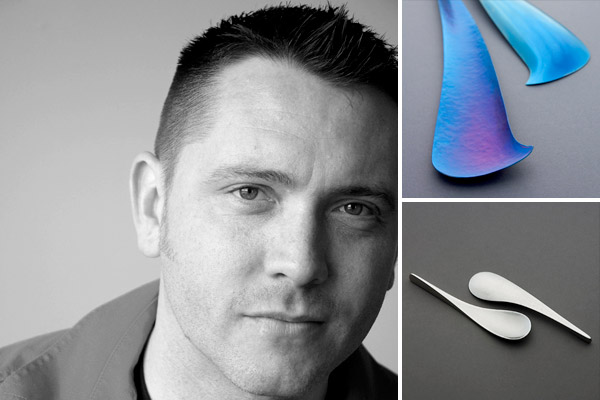
oliver smith | Email | Website
Where and what did you study and what year did you graduate?
Master of Philosophy (Gold and Silversmithing), 2003, Australian National University.
Bachelor of Visual Arts Honours (First Class)(Gold and Silversmithing), 2000, Australian National University.
Bachelor of Visual Arts (Jewellery and Object Design), 1995, Sydney College of the Arts., University of Sydney.
Where did you head after graduating?
In between studying I spent time working in jewellery, silversmith and coppersmith studios in New Zealand, Mexico, Germany and England. During my postgrad study I also taught at a number of tertiary institutions. Upon completing my Masters I established my own workshop and continued to take part in exhibitions, commissions and collaborations.
When did you launch your own business?
In November 2004.
What motivated you to start your own business?
Starting a business was a natural progression from making unique objects by hand to moving into producing multiples.
How would you describe your business to someone who didn’t know you?
Conversationally I say I make cutlery and tableware and that I work as both a silversmith and designer. More formally I’d say that I create tableware to enhance the sharing of a meal and that this ranges from production design to unique objects.
How would you describe the products you design to someone who hadn’t seen them?
Beautiful functional tableware with flowing lines, pure forms, clean surfaces and bold proportions. I always aim for longevity which leads to a certain classicism.
What are the most challenging parts of being a designer running a small business?
Discipline is required to combine the things I love doing with the less desirable aspects. Budgeting and financial planning are a huge challenge. I’m slowly learning to be more business minded.
What are the next steps for you?
I’m keen to release one and tenderfoot , my next product designs and aim for the global market. Within 12 months I would like to see these objects available in a retail setting and see them in continued production as part of a larger collection.
Comments Off on Oliver Smith
Matthew Conway
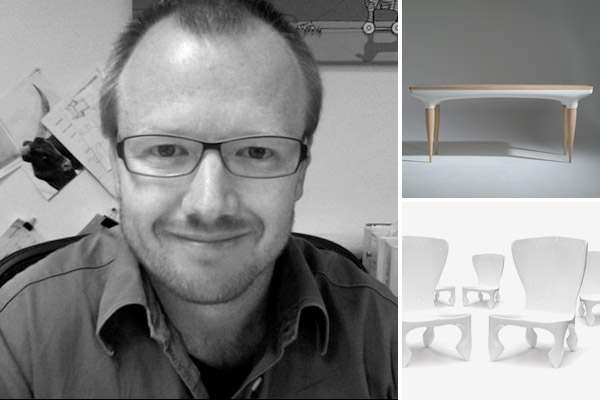
Matthew Conway | Email | Website
Where and what did you study and what year did you graduate?
Bachelor of Industrial Design, 1995, University of Newcastle.
Where did you head after graduating?
I walked the world, went to design fairs, cool cities and looked at stuff. I worked in a shaker furniture shop in London for a while and also as a dresser for Starlight Express.
When did you launch your own business?
In 2003.
What motivated you to start your own business?
I wanted freedom of expression, to create objects of a unique nature and to create a life on my own terms.
How would you describe your business to someone who didn’t know you?
I am continually evolving the product development, exploring ideas and getting them out into the world.
How would you describe the products you design to someone who hadn’t seen them?
My products express beauty, ideas and forms that inspire me. I wish to impart this to others to inform and in turn add joy to their surroundings, actions and lives.
What are the most challenging parts of being a designer running a small business?
Doing all that I envisage is possible.
What inspires your design projects?
Sometimes it is past projects inspiring the new. It is the search for a personal language in my work and trying new applications of ideas and materials. I’m driven to create and produce objects because I don’t see them existing already how I think they should. They should challenge, compliment or provoke an idea of what that object could be.
What are the next steps for you?
I want to grow the business, produce more objects and get them to market in Australia and abroad and continue to be inspired.
Comments Off on Matthew Conway
Kristian Aus
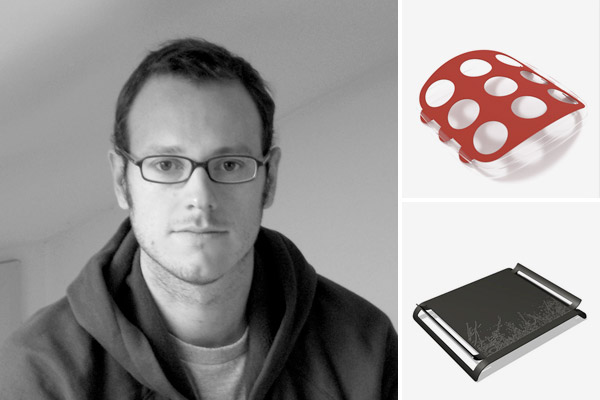
Autumn products | Email | Website
Where and what did you study and what year did you graduate?
Bachelor of Industrial Design, 2002, University of Technology Sydney.
Where did you head after graduating?
After graduating I did freelance design work as well as working in senior designer positions at BlueSky Creative and Bang Design.
When did you launch your own business?
In 2007.
What motivated you to start your own business?
I wanted more creative control over my work and needed an opportunity to further my design experience and earning potential.
How would you describe your business to someone who didn’t know you?
I operate a design consultancy that also designs and manufactures products. The products are not in any one area but include furniture, lighting and homewares.
How would you describe the products you design to someone who hadn’t seen them?
They have a clean aesthetic, simple construction and are easy to use.
What are the most challenging parts of being a designer running a small business?
I think the most difficult part is building up contacts in manufacturing and sales.
What inspires your design projects?
A desire to produce products that are aesthetically clean and playful.
What are the next steps for you?
A goal for the next year would be to invest further time and resources into developing more complex designs and to gain greater exposure in the international design marketplace. This includes looking to gain media exposure in Japan, Asia and Europe. In five to ten years I would like Autumn to be a known brand in Australia, Japan and Europe. I am also interested in gaining collaborative partnerships with manufacturing brands abroad.
Comments Off on Kristian Aus
Keryn Hughes
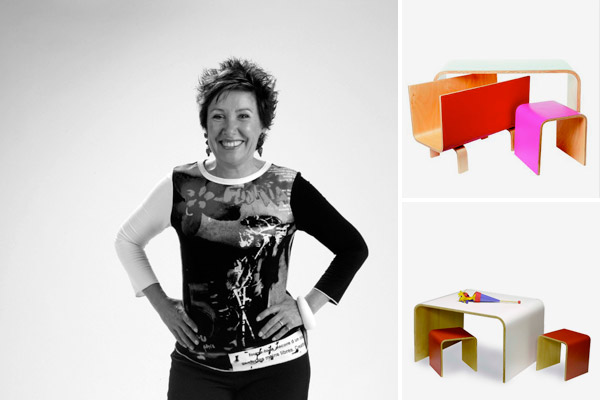
In Your Room | Email | Website
Where and what did you study and what year did you graduate?
Bachelor of Commerce Honours (First Class with University Medal), 1982, University of New South Wales.
Where did you head after graduating?
After graduating I spent seventeen years working in the stimulating and rewarding field of industrial relations.
When did you launch your own business?
I came to furniture design later than most. I registered my business the week I turned forty!
What motivated you to start your own business?
I was at a critical career juncture, raising three children and taking stock of the direction of the second half my working life would take. I decided to merge my lifelong passion, but until then only fringe involvement with design with my work, life and parenting skills.
How would you describe your business to someone who didn’t know you?
In Your Room designs and produces contemporary moulded plywood furniture for kids and adults in domestic and commercial environments. We are committed to sustainable, multi-functional. affordable designs.
How would you describe the products you design to someone who hadn’t seen them?
Think uncluttered lines in functional, sustainable pieces embracing the warmth and quality of wood with the option of a coloured laminate.
What are the most challenging parts of being a designer running a small business?
It’s difficult to earn a decent living and it’s exhausting doing everything yourself. You need to team your own design and other skills with expertise in a whole range of areas for your business to have a chance of thriving, not merely surviving.
What are the next steps for you?
Cementing and expanding our relationships with architectural and design firms should enhance our presence in the commercial and public project arena. We also need to better enunciate our environmental credentials and build on our long history of environmental responsibility. We are very excited about a couple of export opportunitiesbut perhaps most exciting for me personally is my plan to develop a new range of products I have identified as a growth area and in which I believe I have a strength.
Comments Off on Keryn Hughes
Ke Wu
Where and what did you study and what year did you graduate?
Bachelor of Design Honours, 2001, College of Fine Arts, University of New South Wales.
Where did you head after graduating?
I worked in graphic design and specialised in environmental graphics.
When did you launch your own business?
Late 2006.
What motivated you to start your own business?
Freedom.
How would you describe your business to someone who didn’t know you?
I am a designer of jewellery and home accessories.
How would you describe the products you design to someone who hadn’t seen them?
Modular, graphical and intriguing.
What are the most challenging parts of being a designer running a small business?
Identifying yourself to others and looking after all aspects of a business, for example manufacturing, marketing, accounts and sales, with limited resources.
What inspires your design projects?
Everything because inspiration can come anytime.
What are the next steps for you?
We plan to keep designing and expand overseas.
Comments Off on Ke Wu
Katie Ledlin
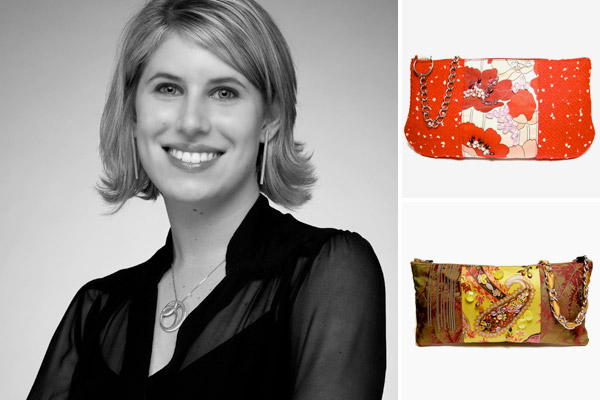
Three Bags Mine | Email | Website
Where and what did you study and what year did you graduate?
Bachelor of Architecture Honours (First class), 2006, University of Sydney.
Bachelor of Design (Architecture) 2003, University of Sydney.
Where did you head after graduating?
I worked for architecture firms part time at university. I now work as an architect with GLA on high end residential projects, retail fitouts and commercial interiors and design for Three Bags Mine after hours!
When did you launch your own business?
Three Bags Mine was officially launched in my final year of university in 2006.
What motivated you to start your own business?
As a struggling uni student, I started making bags as birthday gifts for close friends. The feedback and huge amount of encouragement from them inspired me to believe that I could establish my passion in a small business .
How would you describe your business to someone who didn’t know you?
A high end, luxury handbag label targeting a very niche client market.
How would you describe the products you design to someone who hadn’t seen them?
Portable art. All the pieces are one-off originals, designed and handmade by myself. It involves quite a laborious process to make but the end result is a highly detailed, well finished, quality piece that should be yours to use and keep for a lifetime.
What are the most challenging parts of being a designer running a small business?
Learning to plan for the downs as well as relishing the highs. Retaining the passion and staying on course when things don’t go your way is a challenge, but essential to making that success.
What inspires your design projects?
The first bag I made was inspired by a collection of paisley silk scarves I inherited from my grandmother. The use of rich, textured and opulent fabrics has always inspired my designs.
What are the next steps for you?
I think it’s important to establish a strong identity in Australia before venturing to an international stage, so my focus during the next two years will be to broaden local brand awareness and reach more of that niche market here.
Comments Off on Katie Ledlin
Karie Soehardi
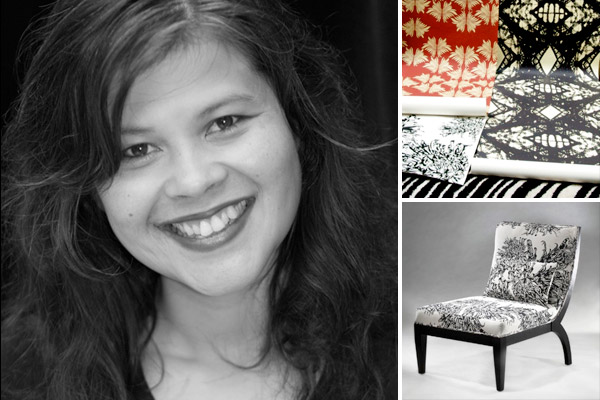
Ella and Sofia | Email | Website
Where and what did you study and what year did you graduate?
Certificate Fashion Design, 2001, East Sydney TAFE.
Bachelor of Visual Arts (Jewellery and Object Design), 1994, Sydney College of the Arts, Sydney University.
Where did you head after graduating?
I moved to London and worked for milliner Stephen Jones before moving to the Middle East. Later I returned to Sydney and worked in buying at David Jones.
When did you launch your own business?
In August 2005.
What motivated you to start your own business?
I wanted to use my creative skills alongside the business skills I had attained.
How would you describe your business to someone who didn’t know you?
Ella and Sofia is an interior accessories studio producing products such as hand printed wallpapers, screenprinted fabrics, soft furnishings and tableware.
How would you describe the products you design to someone who hadn’t seen them?
Eclectic, feeling old school with a contemporary twist.
What are the most challenging parts of being a designer running a small business?
Doing it all, no matter what you delegate you need to be on top of everything that is happening, not just what you are working on personally.
What inspires your design projects?
Traditional skills and wanting to be able to customise to client needs, to get back to a service where everything is not volume and same-same aesthetically.
What are the next steps for you?
The next steps for Ella and Sofia are to build on the company’s resources in both production and business development. I hope that it will become a studio where designers and architects feel that they can come for unique and interesting accessories. I want to develop the brand both here in Australia and throughout the world.
Comments Off on Karie Soehardi
Kara Smith
Where and what did you study and what year did you graduate?
Associate Diploma Graphic Design, 1993, TAFE NSW.
Where did you head after graduating?
I spent fourteen years as a graphic designer and illustrator working all over Australia.
When did you launch your own business?
In July 2007 I left full time work to head out on my own.
What motivated you to start your own business?
It was initiated by the response I got from making my handmade handbags. It started out as just a bit of fun but kept going.
How would you describe your business to someone who didn’t know you?
Delicious handmade accessories made out of vintage, retro and recycled fabrics, buttons and buckles.
How would you describe the products you design to someone who hadn’t seen them?
My handmade handbags and scarves are created from my own patterns and designs. The bags, including the lining, are made with fine recycled and vintage fabrics. These are matched up with lovely old buttons, brooches, belt buckles and fabulous trims – all recycled of course!
What are the most challenging parts of being a designer running a small business?
The most challenging part is having the time to do everything yourself from sewing and creating the bags to uploading to web and promoting them to dispatching, knowing what to put up as first priority, problem-solving, cash management and bookkeeping!
What inspires your design projects?
Everything and anything. I have been inspired by the curve of a beautiful vintage armchair, to creating a bag based around a single art deco brooch. Sometimes I can pick up a fabulous old coat and marvel at the detail on the buttons and pockets. This then creates the ball rolling for something different to happen to the next bag.
What are the next steps for you?
I have just introduced my 10totes range, which are ten totes released exclusively at a time. Each is made from very lush, recycled fabrics and is perfect as a hold-all, baby bag or for anyone that likes to keep it all in one place.
Comments Off on Kara Smith
Jonathan Baskett
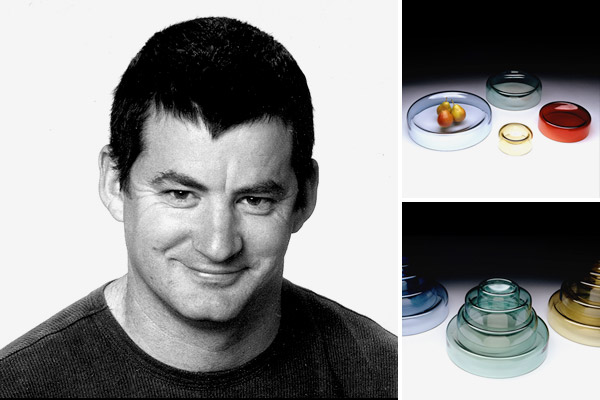
Jonathan Baskett Creative | Email | Website
Where and what did you study and what year did you graduate?
Master of Visual Arts (Product Design), 2003, Canberra School of Art.
Bachelor of Visual Arts Honours, 1996, Canberra School of Art.
Where did you head after graduating?
I spent three years working in various glass studios in Europe, New Zealand and Mexico. I then returned to Australia in 1998 and started my own production studio in Sydney.
When did you launch your own business?
I launched it first in Bremen Germany then in Sydney.
What motivated you to start your own business?
A genuine belief in minimal and original designed objects in glass, anti-design timeless objects that last the test of time and are functional, fun and contemporary.
How would you describe your business to someone who didn’t know you?
I design for industry and design and make glassware under my own label.
How would you describe the products you design to someone who hadn’t seen them?
Clean and minimal, colourful fun, designed for the those that know what their function is.
What are the most challenging parts of being a designer running a small business?
Allocating the right amount of resources and time to all the challenges such as production, promotion, presentation and research and development.
What are the next steps for you?
More designing, collaborating, travelling and spending more time with the people I love.
Comments Off on Jonathan Baskett
John Skinner
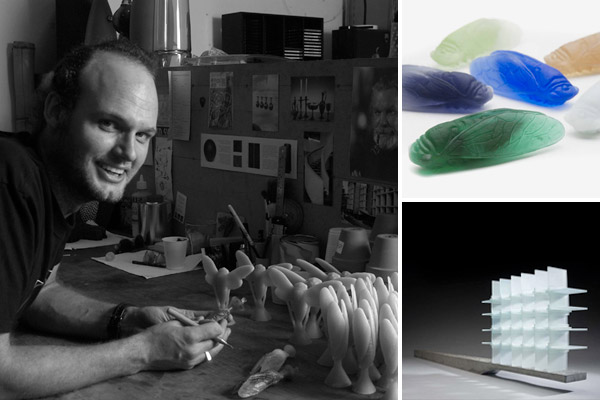
Studio SKINKY | Email | Website
Where and what did you study and what year did you graduate?
Bachelor of Visual Arts (Glass and Object Design), 2007, Sydney College of the Arts, University of Sydney.
Bachelor of Business Administration, 2002, Central Queensland University, Sydney International Campus.
Where did you head after graduating?
From 2006 to the present, I’ve been a technical assistant at Denizen Glass Studio and since graduating in 2007 I’ve had my own studio space there.
When did you launch your own business?
I launched my own business in early 2008.
What motivated you to start your own business?
I think it was a genuine belief in the potential for my ideas, combined with an understanding that if my progress was measured then I would succeed.
How would you describe the products you design to someone who hadn’t seen them?
Collectable, original and contemporary.
What are the most challenging parts of being a designer running a small business?
It’s alright to have a great idea but if you can’t deliver it in a cost effective way then its just a dream. I spend a lot of time ironing out my production processes trying to continually refine and improve. It is critical because the more I can free myself then the more time I’ll have to focus on my new work.
What inspires your design projects?
History and also learning about the success of industrial art enterprises is a driving force behind the inspiration of my design work. Architecture, the natural environment and the fine arts are some areas that I have drawn inspiration from.
What are the next steps for you?
I would like to have all of the operational components of my business organised within eighteen months, and within three years my own independent studio space. I want to retain intellectual control over my production work but possibly license out manufacturing. And I want to reach global markets through an online presence with e-commerce facilities.
Comments Off on John Skinner
Jen Roberts and Sandra Mason
Where and what did you study and what year did you graduate?
We both studied hospitality management a year after high school which is where we met. We both graduated in 2000. I went on to supervise and then manage cafes and restaurants while Sandra decided hospitality wasn’t for her and went on to study photography, graduating in 2003.
When did you launch your own business?
At the end of 2004.
What motivated you to start your own business?
It was all about being creative and having a platform for us to share our work with the world. After we produced our first run of t-shirts it was really the reactions that we got, backed up with sales that made us realise that we could turn this into a feasible business.
How would you describe your business to someone who didn’t know you?
IMOK invites you into their world, a world that says ‘I’m ok if you are? ‘ This philosophy can be felt flowing out of a range of quirky, cute, layered and at times melancholy collection of illustrations. Designs are adapted into various art forms including a range of girls and guys t-shirts, hats, scarves, canvases and prints.
What are the most challenging parts of being a designer running a small business?
Cash flow and time would be the most difficult things, meaning having enough money to see all of your creative visions come to life and as artists you want to create all the time. But with a business comes paperwork, accounting, marketing, answering calls and emails leaving only a little time to do what you really want to be doing.
What inspires your design projects?
We like things with a street edge and things that are unconventional. We are inspired by all art forms especially graffiti, stencil art, graphics, photography and character design because of the underground and edgy quality that comes with them.
What are the next steps for you?
We would like IMOK to exist and be stocked worldwide. The idea for IMOK is to have the characters, designs and message reach as many people as possible. By bringing not only a new trend in street clothing but a powerful message that is delivered by distinctive IMOK characters.
Comments Off on Jen Roberts and Sandra Mason
James Lord
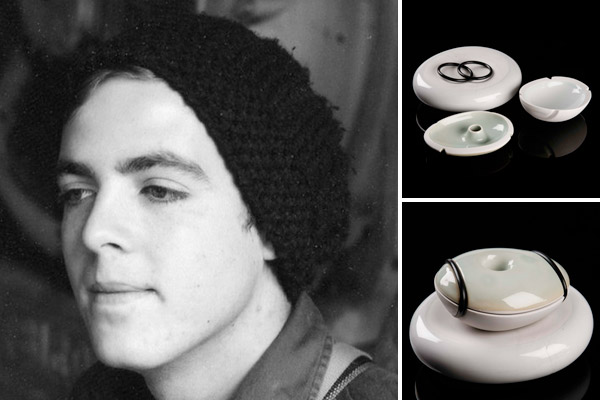
Nama Rupa | Email
Where and what did you study and what year did you graduate?
Bachelor of Industrial Design, 2005, University of New South Wales.
I am currently completing a Masters in Design (Ceramics Design for Studio Production) at the College of Fine Arts.
Where did you head after graduating?
I thought I was going to be a famous bag designer so I enrolled in a Masters of Design course at first majoring in textiles with ceramics and jewellery as other interests. I soon found that I was pouring my energy into my ceramics work as it allowed me to utilise my training in industrial design and at the same time explore the use of a traditional material in untraditional ways.
When did you launch your own business?
I launched my own design business in March 2007, ten months after starting full time work in the design industry.
How would you describe your business to someone who didn’t know you?
I operate a design consultancy and have had clients ranging from artists and designers applying for venture capital, research laboratories requiring 3D models and prototypes for educational purposes to sheet metal manufacturers. But I consider my real business my passion for designing and making in the ceramic medium.
How would you describe the products you design to someone who hadn’t seen them?
Fun, meaningful, unique, simple, well made.
What are the most challenging parts of being a designer running a small business?
In the consultancy side of the business it chasing work and maintaining a steady flow of jobs. Then its balancing your time between projects that may not make you much money but bring you extreme pleasure and enjoyment in their development with those that may not be so exciting but will definitely make you money.
What are the next steps for you?
Once I have gained adequate funding to see some projects through to market, I aim to build my own home-based studio. I would like to focus on designing and developing objects and homewares to be produced in limited production runs from my studio. I also intend to license a number of designs to established manufacturers so that I may begin to generate some sort of reliable income.
Comments Off on James Lord
Ilias Fotopoulos
Where and what did you study and what year did you graduate?
I undertook a Bachelor of Design (Fashion and Textile Design) at University of Technology Sydney.
Where did you head after university?
I carried plates by night and experimented with textiles non-stop by day working on the techniques that UTS lecturers were telling me were not possible and viable. I then freelanced for Cloth for two or three years. I also studied everything from textile printing, pattern drafting, draping and dyeing technology at TAFE.
When did you launch your own business?
Late 2003.
What motivated you to start your own business?
I began my business because I didn’t want to be caught up in the industry approach of being dictated to by trend forecasts. I also had the desire and instinct to develop my own aesthetic.
How would you describe your business to someone who didn’t know you?
My business is reconfiguring notions of wallpaper and textile design.
How would you describe the products you design to someone who hadn’t seen them?
Changeable, fresh, eclectic, identifiable, organic and techno merged together.
What are the most challenging parts of being a designer running a small business?
Keeping up with day to day running of a business.
What are the next steps for you?
I plan to establish greater links with manufacturers in Japan, Europe and the United Kingdom including collaborations. I also want to continue the braille project as a larger publishing and design project and venture into clothing.
Comments Off on Ilias Fotopoulos
Henrietta Gothe-Ellis
Where and what did you study and what year did you graduate?
Bachelor of Design, 2003, College of Fine Arts, University of New South Wales.
Where did you head after graduating?
2DESIGN was founded the day after graduation. My signature piece and first major design project AURA was in its prototype stage, so I focused on getting funds together to put the work into production.
With a finished product range ready, I began exhibiting in late 2003. I won an Australian Design Award in 2004 and have continued to exhibit and work on design collaborations around the world.
When did you launch your own business?
In March 2003.
How would you describe your business to someone who didn’t know you?
I’m a Sydney based, multidisciplinary designer. My company 2DESIGN also deals with graphics, layout, advertising campaigns, corporate identity, marketing material, brochures and websites on a freelance basis. I am continually working on new ideas to add to the existing 2DESIGN product range.
How would you describe the products you design to someone who hadn’t seen them?
My signature piece AURA is a seamless fusion of furniture, lighting and sculpture. Inspired by the nautilus shell, AURA combines a seemingly natural, organic form with modular practicality and ergonomic design that allows for unlimited seating configurations.
What are the most challenging parts of being a designer running a small business?
Maintaining belief in your product during slow sales periods. Being based in Australia, coping with a relatively small market and dealing with rising freight and shipping costs. Balancing ethical concerns with productivity, sustainability and environmental impacts in all aspects of the design process.
What are the next steps for you?
I hope to see AURA sales increase through continuing to market the product, participating at key design exhibitions and by expanding the existing 2DESIGN range. I am planning to add a children’s version, AURA MINI, and am considering seeking investors to fund this next project. I also plan to develop an illuminated table that compliments the AURA range and hope to have a prototype ready in two to three years.
Comments Off on Henrietta Gothe-Ellis
Gareth Brown
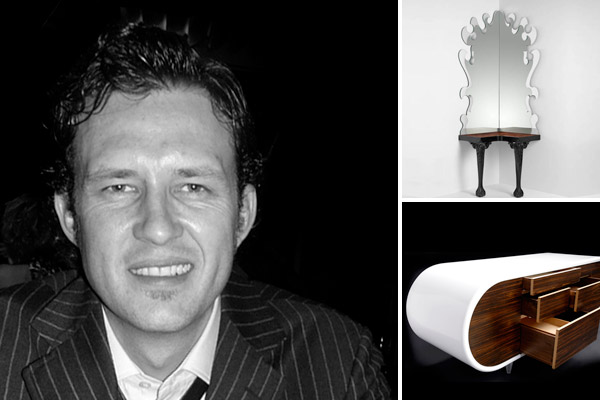
Gareth Brown | Email
Where and what did you study and what year did you graduate?
City and Guilds Handcrafted Furniture Making, 2006, City of Bristol College, United Kingdom.
Where did you head after graduating?
While studying I worked for a bespoke kitchen and furniture company as a cabinetmaker. When I was working there I also produced some pieces for myself which I exhibited at several exhibitions in London. I then moved home to Adelaide to be an associate furniture designer at JamFactory.
When did you launch your own business?
I launched my own business in 2007.
What motivated you to start your own business?
My motivation came from the desire to be creative and work for myself. Also receiving positive feedback about my work gave me the confidence to pursue making as a career.
How would you describe your business to someone who didn’t know you?
I provide a furniture design and manufacturing service working closely with private clients and architects. I produce freestanding, one-off and limited run pieces that are sold through galleries and retail outlets as well as site specific commercial and residential fit outs.
How would you describe the products you design to someone who hadn’t seen them?
My products are made with longevity in mind structurally and visually. I incorporate hardwood and lacquer into most of my furniture using meticulous craftsmanship.
What are the most challenging parts of being a designer running a small business?
Trying to fit 30 hours into 24 .
What inspires your design projects?
The materials I am using and the function of an end product. My surroundings and the interactions with people also play a vital role.
What are the next steps for you?
The next step for me is to finish my associateship at the JamFactory. I want to then set up a workshop and shopfront in Adelaide and sell my own range of furniture.
Gareth Brown received a scholarship from Arts SA and CraftSouth to participate in Springboard Stage One.
Comments Off on Gareth Brown
Emma Elizabeth Coffey
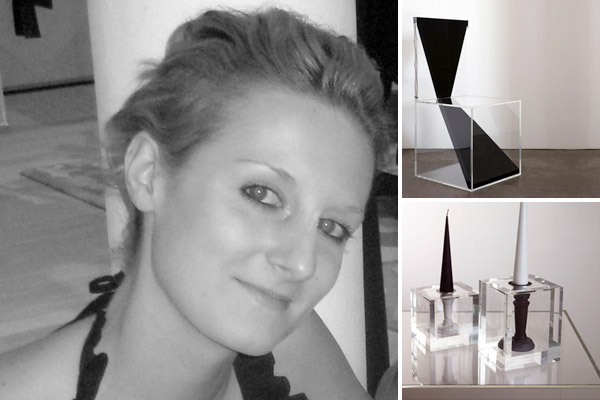
Emma Elizabeth Designs | Email | Website
Where and what did you study and what year did you graduate?
Scenografia (Commercial Interior Design), 2006, Istituto Europeo di Design, Milan.
Where did you head after graduating?
After graduating, I launched Emma Elizabeth Designs in Sydney and specialised in freelance commercial interior design, styling and art direction. I have been working with clients including Moet & Chandon, Harpers Bazaar, Megan Morton and Domayne.
When did you launch your own business?
I launched the business at Zona Tortona, Salone del Mobile in Milan in April 2006.
What motivated you to start your own business?
I wanted to utilise all of my design skills in a unique and exclusive way and I could not find a company that appealed to all of my senses. I found creating Emma Elizabeth Designs was the best solution.
How would you describe your business to someone who didn’t know you?
Emma Elizabeth Designs specialises in freelance design, fashion runway, product, exhibition, art direction and styling roles.
How would you describe the products you design to someone who hadn’t seen them?
My furniture and interior products are very conceptual. I work within a monochromatic scheme focusing on shadows and silouhettes. They are statement pieces driven towards the hotel, hospitality, retail and commercial design sectors.
What are the most challenging parts of being a designer running a small business?
The most challenging part of running a small design business is that you are the sole entity. The administration side is always a struggle.
What inspires your design projects?
I was inspired to release a full collection of interior furniture pieces after receiving a series of emails from a representative at Philippe Starck’s studio in Paris asking to see more of my work.
What are the next steps for you?
I would like to take my business and designs out into a global market, working not neccessarily with retailers, but closely with certain designers and architects to develop my lines further into the commercial design and consignment market.
Comments Off on Emma Elizabeth Coffey
Craig Bunting
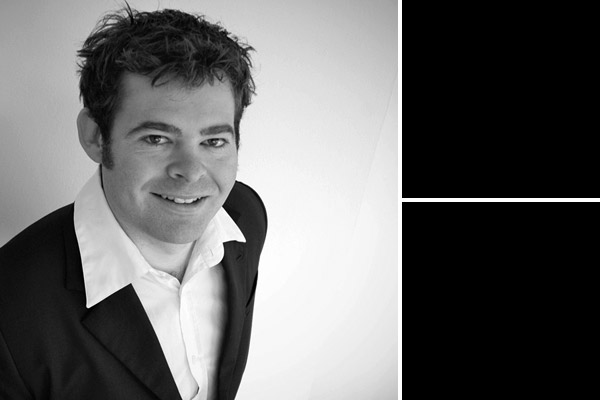
4ormfunction | Email | Website
Where and what did you study and what year did you graduate?
Bachelor of Industrial Design Honours, 2001, Wellington School of Design, Massey University, New Zealand.
Where did you head after graduating?
After graduating I designed two full suites of furniture consisting of 28 pieces for Davies Furniture. These were sold through out New Zealand and Australia. I then worked for 4ormfunction for three years as a graduate designer and then as Managing Director for a company called MagicSeal for 4 years. I moved to Australia from New Zealand in late 2007.
When did you launch your own business?
In February 2008.
What motivated you to start your own business?
Having worked for two successful businesses in New Zealand and gaining the necessary skills to run one, I decided to take the plunge and start one in Sydney.
How would you describe your business to someone who didn’t know you?
Young, innovative, sustainable materials, knowledge and no frilly stuff.
How would you describe the products you design to someone who hadn’t seen them?
Research, research, research… We start with the product or idea, strip it back to its bare essentials, then comes the process of building it again, material by material, part by part, paying meticulous attention to the functionality and adding some clean form to the recipe. The result is 4ormfunction. A fun, fresh innovative product with style.
What are the most challenging parts of being a designer running a small business?
I think the most challenging part comes from the isolation of being the only employee in my office thus far. I’m getting better at talking to myself!
What inspires your design projects?
Everyday I look at or find something that inspires me. My biggest inspiration would be looking at products or objects and wanting to make them better.
What are the next steps for you?
Here in the Sydney office we are going to focus more on our own product line and a little less on consulting for clients fulltime. Five years from now 4ormfunction will be a collective of the best minds and a creative little hot house.
Comments Off on Craig Bunting
Chris Byrne
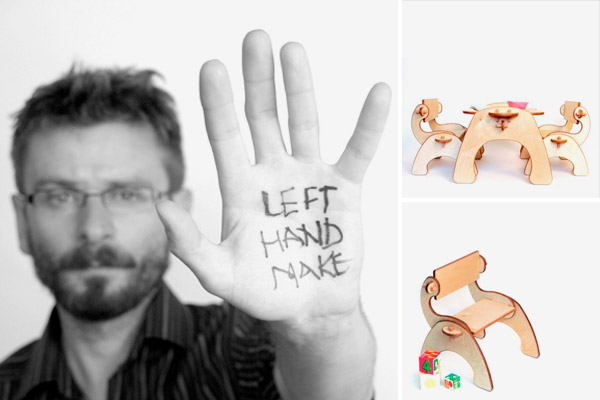
Left Hand Make | Email | Website
Where and what did you study and what year did you graduate?
Furniture Design and Manufacture, 2003, Glasgow College of Building and Printing, Scotland.
Where did you head after graduating?
Shortly after graduating I shrugged off the Glasgow rain and headed for more hospitable shores. Upon arriving in Sydney I started Left Hand Make and began to work on a series of individual commissions and some commercial work.
When did you launch your own business?
I began Left Hand Make in 2004 with a twinkle in my eye and my socks pulled right up. It was part time then and very exciting.
What motivated you to start your own business?
I had a fair idea of what I thought I wanted to do and was hungry to get started. Probably the biggest reason was that I felt that working for someone will earn you a wage but with your own business there are no boundaries – either the sky or debtors’ prison.
How would you describe your business to someone who didn’t know you?
Left Hand Make is a designer and maker studio that produces products for adults and children that speak with integrity and personality. We take responsibility for the impact of our work on the community and the environment.
How would you describe the products you design to someone who hadn’t seen them?
Our small one products are children’s furniture you don’t need to hide.
What are the most challenging parts of being a designer running a small business?
That I don’t just get to be a designer and maker. I’m the marketer, retailer, distributor, project manager, delivery boy, that bloke with the broom.
What inspires your design projects?
With small one it was the lack of good quality locally produced children’s furniture. In general I am inspired by trying to find a simple way of being unique and offering something which is not too driven by the here and now.
What are the next steps for you?
Aside from the obvious goal of world domination, a Milan Furniture Festival stand, I’d like to see us with a few more products and a bit of penetration into overseas markets. I’d like to get bigger but not too big and staff, I’d love staff.
Comments Off on Chris Byrne
Benjamin Gallagher
Where and what did you study and what year did you graduate?
Bachelor of Industrial Design, 2003, University of Newcastle.
Where did you head after graduating?
I was travelling, cooking, and roofing. A combination of activities whilst indirectly related to design, they were far enough removed from it for me to be able to plan with objectivity exactly when and how I would return to the industry.
When did you launch your own business?
In 2006.
What motivated you to start your own business?
The itch became unbearable.
How would you describe the products you design to someone who hadn’t seen them?
They are raw, monolithic and austere structures for the home. They plod along, inspired by the rhythm of the music I listen to and the movies I absorb.
What are the most challenging parts of being a designer running a small business?
Developing a reliable network for manufacture. No one is more passionate about what we do than ourselves. I have found it difficult to accept whenever goods are returned and they are not to my standards. The end result is that I take on too much myself out of a lack of trust for anyone else. Also trying to fit a full time design business into three days a week does become quite tiring.
What inspires your design projects?
It changes daily but I can be assured of the constant flow which emanates from the arts.
What are the next steps for you?
My plan is to establish a reliable network of artisans and craft people to assist me through the next five years, to consolidate my portfolio by investing in prototypes. Also to invest in a proper workshop and purchase wood and metalwork machinery capable of supplying small and limited production runs of my designs to the Australian market.
I want to increase my profile through exhibition time in both Sydney and Newcastle galleries. It has always been a dream of mine to run a shop. It may be a purist ideal but I plan to create the perfect environment for displaying my wares.
Comments Off on Benjamin Gallagher
Andrew Simpson
Where and what did you study and what year did you graduate?
Bachelor of Industrial Design Honours, 2005, University of Technology Sydney.
Where did you head after graduating?
I worked as a glass blower and a design consultant then started to my own business, Vert Design.
When did you launch your own business?
In September 2005.
What motivated you to start your own business?
Dreams of world domination, that and I don’t play well with others.
How would you describe your business to someone who didn’t know you?
We are a small design house that produces simple elegant products.
How would you describe the products you design to someone who hadn’t seen them?
All of our products encourage people to interact with them. They work seamlessly with the human form and are made from robust materials that last.
What are the most challenging parts of being a designer running a small business?
Not having the money to make the product that I would love to make.
What inspires your design projects?
A love of design and an enjoyment of simplicity.
What are the next steps for you?
I am still aiming for world domination but the next two to five years will see some new and exciting long term projects come to market.
Comments Off on Andrew Simpson
Andrew Fedrigo
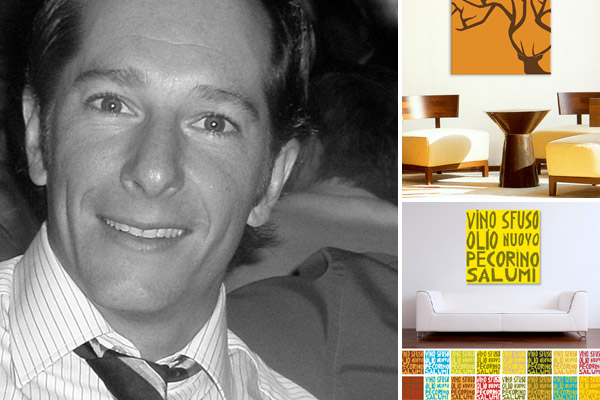
Scape Interiors | Email | Website
Where and what did you study and what year did you graduate?
Advanced Diploma in Design and Advertising, 1995, Billy Blue Graphic Design and Advertising.
Where did you head after graduating?
With my beloved Posca paint markers, my informal design career started with drawing surf logos on the back of text books in the early school days. Today, my design career has been diverse, working in award winning studios in my home town of Sydney and proudly overseas in Canada and the UK.
When did you launch your own business?
In March 2008.
What motivated you to start your own business?
The mission at Scape Interiors is to rid the world of blank walls, one blank wall at a time and to give life to a brand by providing a service where individuals from all walks of life can easily express themselves.
How would you describe the products you design to someone who hadn’t seen them?
Design is individual, we all have our own personal sense of style and colour. Scape Interior products reflect your personal style, you choose what works best for you through the language of colour.
What are the most challenging parts of being a designer running a small business?
Finding the best ways to spend the marketing dollar and getting your products in front of the right people is a huge learning curve and can be a costly one.
What inspires your design projects?
Inspiration comes from all walks of life and various mediums. I’m always keeping an eye out for old posters, signs, type and hand written fonts in English and other languages. Colour and design is a global language and I love to source inspiration from all walks of life.
What are the next steps for you?
I hope that Scape will be a haven for like-minded people, pursuing the same goals and positive visions for creating new designer inspired environments. I want it to become an energetic and successful business that is independent of me, allowing me to focus on business momentum and entrepreneurial opportunities. The company will forever be at the forefront and strive to be the industry leading avenue for people to tap into their own lives and create their own visual statement.
Comments Off on Andrew Fedrigo
Amy Cunningham
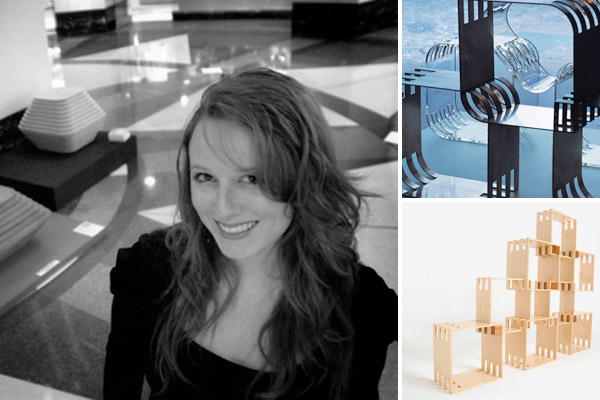
Zema Designs | Email | Website
Where and what did you study and what year did you graduate?
Bachelor of Design Honours, 2006, College of Fine Arts, University of New South Wales.
Where did you head after graduating?
I completed work experience at Woodmark International Furniture in 2005 and have been working as a creative designer for Westfield Design and Construction for the past three years.
When did you launch your own business?
In 2006.
What motivated you to start your own business?
It was the desire to create adaptable modular furniture for the Australian market.
How would you describe your business to someone who didn’t know you?
Zema Designs is a furniture and object design company concept for the production of adaptable modular furniture for both the domestic and commercial markets.
How would you describe the products you design to someone who hadn’t seen them?
Zema Designs produces furniture pieces that are designed and made to last, with their simple function, elegance and adaptability. Locking connections between elements of the furniture is a recurring theme in my work.
What are the most challenging parts of being a designer running a small business?
For me the most challenging part is the cost of manufacture of furniture in Australia. I try to over come this by creating simple functional forms with the least amount of labour and components possible.
What inspired your design projects?
Furniture design became my focus and my passion through observing my family’s close connection to furniture in their lives.
What are the next steps for you?
In the next two to five years, I aim to be running a successful design business with Australian made and designed products with local and overseas distribution. I aim to integrate my skills into a holistic design business with a range of furniture and a design consultancy for interiors and custom pieces.
Comments Off on Amy Cunningham
Alex Noble
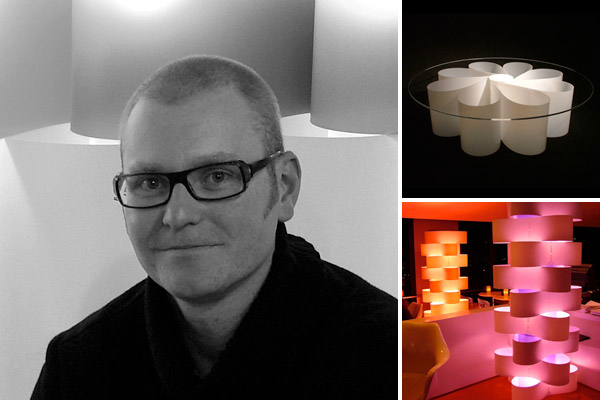
Alex Noble Creations | Email | Website
Where and what did you study and what year did you graduate?
I studied graphic not product design so find I am always learning.
Where did you head after graduating?
I worked in film and TV, sets and props before moving into freelance camera work on everything including Channel V, Better Homes and Gardens, soap operas, the Olympics, feature films, home shopping and kid’s shows. These creative and technical paths converged to create a good foundation for a design career.
When did you launch your own business?
I launched my own business in 2002.
What motivated you to start your own business?
I had a desire to design full time since it was what I used to do for fun on my days off.
How would you describe your business to someone who didn’t know you?
I work from self-initiated briefs to design, manufacture and distribute modular products including lights, chairs, dividing screens and accessories. Working with mainly flat sheet, eco-friendly materials, the products are customisable within set parameters and are supplied in kit form. I supply stores nationally and ship worldwide via website.
How would you describe the products you design to someone who hadnt seen them?
Bold colours, clean lines, soft, nature inspired forms influenced by 50’s and 60’s design with a modern aesthetic. Flat sheet, eco-friendly materials that are customised and assembled by the end user.
What are the most challenging parts of being a designer running a small business?
Time management and changing gears between ‘play’, i.e. designing and experimenting, and ‘work’ i.e. steering and driving the mechanics of the business.
What inspires your design projects?
I design for myself first. I desire an interior environment that is more about substance of experience, nesting and individual self expression rather than posing, elitism and brand lifestyle. I am inspired by natural forms and the elements.
What are the next steps for you?
I will continue to build on current commercial success by expanding the range of products for my existing retail outlets. I plan to increase international sales via e-commerce as most products ship relatively economically for direct supply.
Comments Off on Alex Noble
